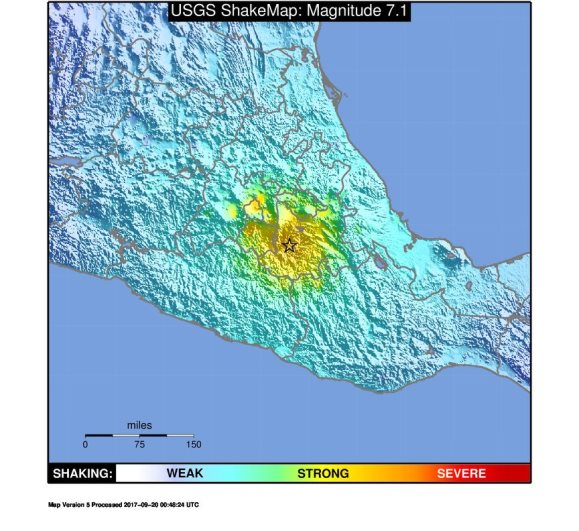M7.1 Puebla Mexico Earthquake
Status: Closed
| Type of posting | Posting date(EST): | Summary | Downloads |
|---|---|---|---|
| Update 1 | 9/22/2017 12:00:00 PM |
|
|
| First Posting | 9/20/2017 9:00:00 AM |
|
First Posting | Summary
Posting Date: September 20, 2017, 9:00:00 AM
The second major earthquake in as many weeks struck Mexico, this time in the state of Puebla at 1:15 p.m. local time (18:15 UTC) on September 19, 2017. This M7.1 earthquake occurred in central Mexico, roughly 55 km south-southwest of the city of Puebla and 120 km southeast of Mexico City, where major damage and hundreds of fatalities have been reported. The USGS located the earthquake at 18.585°N, 98.399°W and the SSN, a local Mexican seismological agency, reported the earthquake at 18.40°N, 98.72°W, offset from the USGS determination by approximately 42 km. Both agencies identified this event as being a relatively deep earthquake with a focal depth of 51 km.
Coincidentally, yesterday’s earthquake struck just after a city-wide earthquake drill was conducted to memorialize the 32nd anniversary of the devastating M8.1 earthquake that struck off the coast of the Mexican state of Michoacán. Considered the most serious natural disaster in Mexico’s history, the 1985 Michoacán quake killed 10,000 people and damaged thousands of buildings; 90% of the total losses resulting from the 1985 quake were sustained in the capital, Mexico City—hundreds of kilometers away.
Yesterday’s quake follows closely on the heels of the M8.1 quake that struck off the coast of the Mexican state of Chiapas close to midnight local time on September 7, which killed nearly 100 people and damaged thousands of buildings in the states of Oaxaca and Chiapas but caused relatively little damage in Mexico City. The USGS does not consider yesterday’s event to be an aftershock of the September 7 event. (Details about why appear in the second paragraph of the next section.)
Seismotectonic Background
Mexico sits on the western edge of the North American plate, which is being underthrust by the eastward-moving oceanic Cocos plate. The subduction of the Cocos plate is occurring at a rate of ~6 to 7 cm/year with a 15-degree dip at the trench. In southwestern Mexico, beneath the states of Michoacán, Guerrero, and Oaxaca, a portion of the Cocos slab is subducting horizontally at a depth of ~50 km. The depth and faulting mechanism of this earthquake’s hypocenter and the normal faulting focal mechanism suggest that it is an intra-slab earthquake within this flat slab segment. Intra-slab earthquakes due to the internal deformation of subducting slabs are quite common in this region of Mexico. These intra-slab earthquakes form an active deep seismicity zone just south of the active east-west oriented trans-Mexican Volcanic Belt, which is the one of the main sources of earthquake risk to central Mexico. Historically at least 10 moderate to large magnitude earthquakes occurred within the flat slab since 1900.
While yesterday’s event comes only 12 days after the M8.1 earthquake that occurred 650 km to the southeast—and both events were related to the subduction of the Cocos plate beneath the North American plate—yesterday’s M7.1 event occurred too far north along the subduction zone to be an aftershock of the September 7, 2017, earthquake according to Paul Earle, a seismologist at the USGS. Earle adds that most aftershocks are within 100 km of the mainshock.

Exposure at Risk
The majority of residential buildings in Mexico are of masonry construction, falling into one of three classifications: reinforced masonry, confined masonry, and unreinforced masonry. Unreinforced masonry is the construction type most vulnerable to shake damage. Commercial buildings in Mexico are primarily of engineered masonry or concrete construction, and are better able to withstand ground motion. In Mexico City, most middle- to upper-class families live in five- to 15-story reinforced concrete commercial dwellings. These buildings are generally well designed and built with high quality materials. However, reinforced masonry and confined masonry buildings still account for a large portion of the building stock of Mexico City.
Building codes in Mexico are among the most comprehensive in the world, but there are no national codes (each of the more than 2,400 municipalities in Mexico enacts and enforces its own regulations); code enforcement can be weak, and designers and contractors often do not fully apply building regulations.
Reported damage
Understandably, in the early aftermath of this event, the focus is on rescue and recovery missions, so damage reports are preliminary and mostly come from Mexico City. The President of Mexico has declared a state of emergency for areas impacted by yesterday’s quake. People in the region have been advised to stay indoors. The number of people who are staying in shelters is unknown, so many in the region are unaccounted for. In Mexico City, dozens of buildings were toppled; about 2 million people have no electricity; telephone lines are down; gas mains may have ruptured, so people have been told not to smoke in the street to avoid explosion; and at least 200 people have been killed in Mexico City and the states of Puebla, Mexico, and Morelos, at least 22 of them children in the capital’s Coapa district, whose schoolhouse collapsed on them. Schools in the region have been closed until further notice.